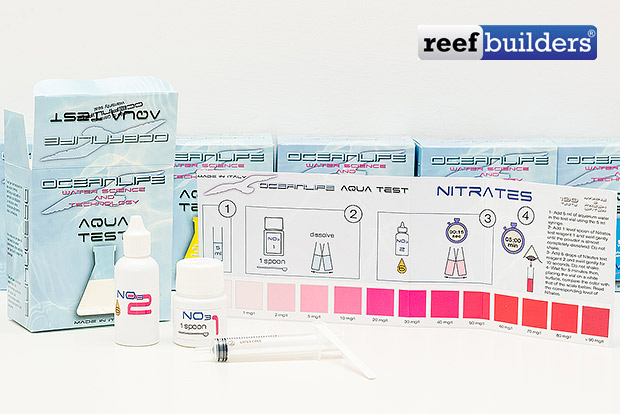Some weeks ago Oceanlife presented his new test kit line. We have just seen the nitrites test kit, and now we take a look at Oceanlife Aqua Test Nitrates. As you can see from the picture the test is composed of a box of generous dimensions that contains the folding carton with the reference colors, a glass test vial, a powder container called NO3-1 and a flask containing the reagent called NO3-2, a syringe and a measuring spoon.
Here below we can see the reference card with instructions in English and designed for each step.
The test is given for 100 measurements, and the scale of detectable nitrite has the following values: 0 – 1 – 2 – 5 – 10 – 20 -30 – 40 – 50 – 60 – 70 – 80 – more than 90 mg/l.
The test is really quite simple. We have to fill the vial with 5 ml of aquarium water. Then we have to put a spoon of the powder contained in the container named NO31 making sure it get directly into the vial. The measuring spoon provided is really very practical. Then we have to add 6 drops of reagent NO32 and we have to gently shake the vial for 10 seconds and put the vial for 5 minutes before reading the value.
Reading is done, as usual, from the top, holding the vial on a white card reference, being careful not to make a shadow with the same vial on the card. The test is extremely simple, also the identification of the color is rather simple, the problem is that there is little space for white reference between the colored squares, and therefore it is not too easy to choose the right color.
Another aspect that I don’t liked a lot is that the drops are not too precise, and sometimes the drops are larger, or there is air that blows.
That said, the test is cheap as it costs 16.07 € in Europe, especially when compared with the Elos test costs 22.90 € and I still think one of the best on the market. In fact, with 3/4 of the price you get a test that supposedly uses the same reagents, with worst drops maker, but all in all enough to detect problems in the aquarium. Given the price the value that emerges is very good.
We remember that all tests, although they have a high number of measurements, should be used not more than 6 months from their first use, in order to prevent incorrect storage can ruined the reagents. Considered the 6-month reference period and 100 measurements means that with this test we can make about four reading a week for a period of six months, at a cost of about 16 eurocents per measurement.




